Analyzing the Role of Culture in International Business Context
VerifiedAdded on 2022/08/20
|10
|2812
|14
Essay
AI Summary
This essay delves into the critical role of culture in international business, highlighting its influence on various aspects of global operations. It begins by defining culture and cross-cultural management, emphasizing the importance of cultural sensitivity in today's globalized economy. The essay then explores how cultural differences between home and host countries necessitate adaptations in corporate practices, including product and service modifications, organizational styles, and decision-making processes. It examines the impact of cultural dimensions, such as power distance and communication styles, on leadership and negotiation. The essay further discusses cultural frameworks proposed by Hofstede and Trompenaars, providing insights into the layers and elements that constitute cultural differences. It also analyzes how cultural nuances affect negotiation styles in different regions, including Asia, the United States, and Europe. The conclusion reiterates the significance of cultural understanding for achieving success in international business, emphasizing its role in avoiding misunderstandings and gaining a competitive advantage.
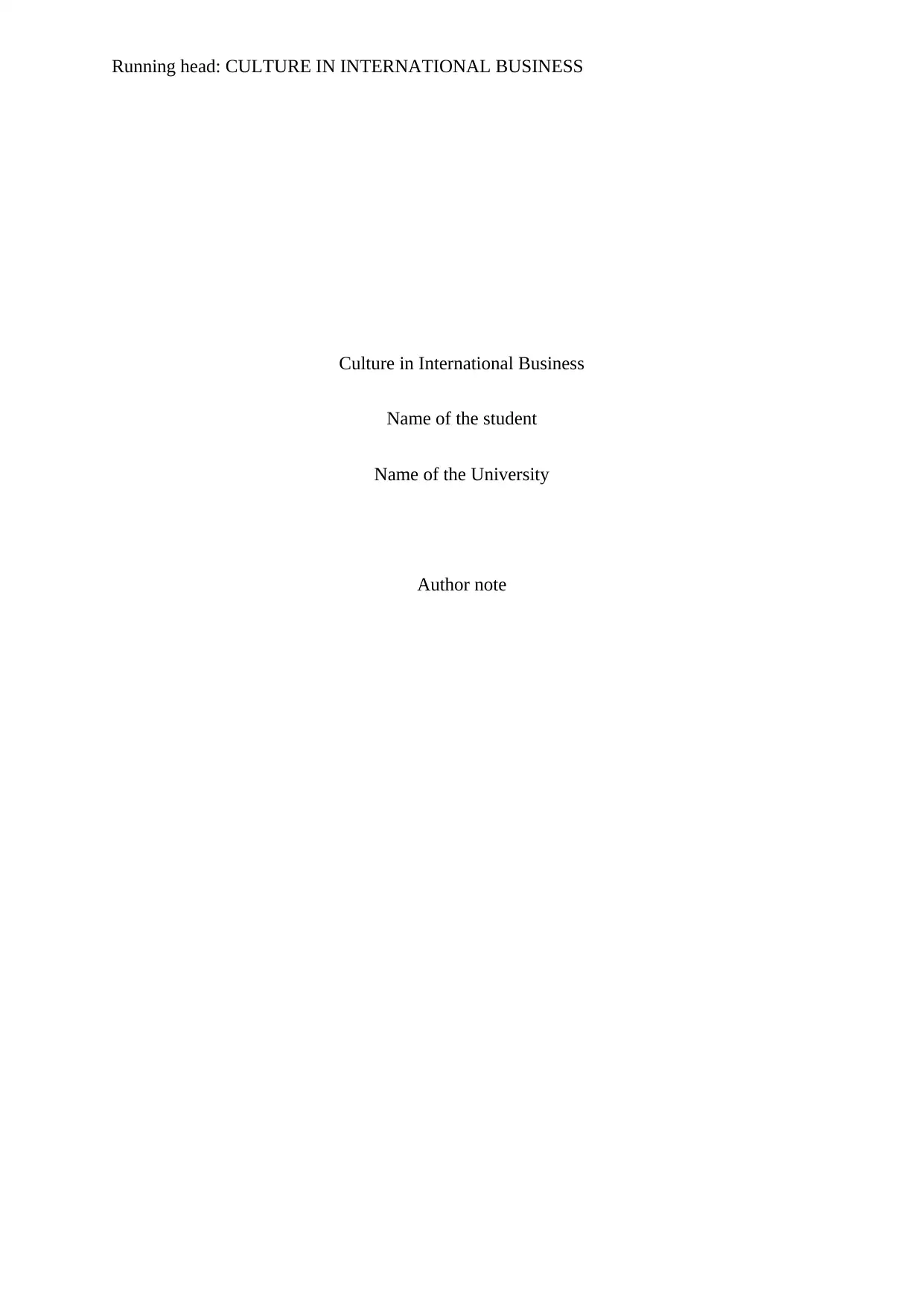
Running head: CULTURE IN INTERNATIONAL BUSINESS
Culture in International Business
Name of the student
Name of the University
Author note
Culture in International Business
Name of the student
Name of the University
Author note
Paraphrase This Document
Need a fresh take? Get an instant paraphrase of this document with our AI Paraphraser
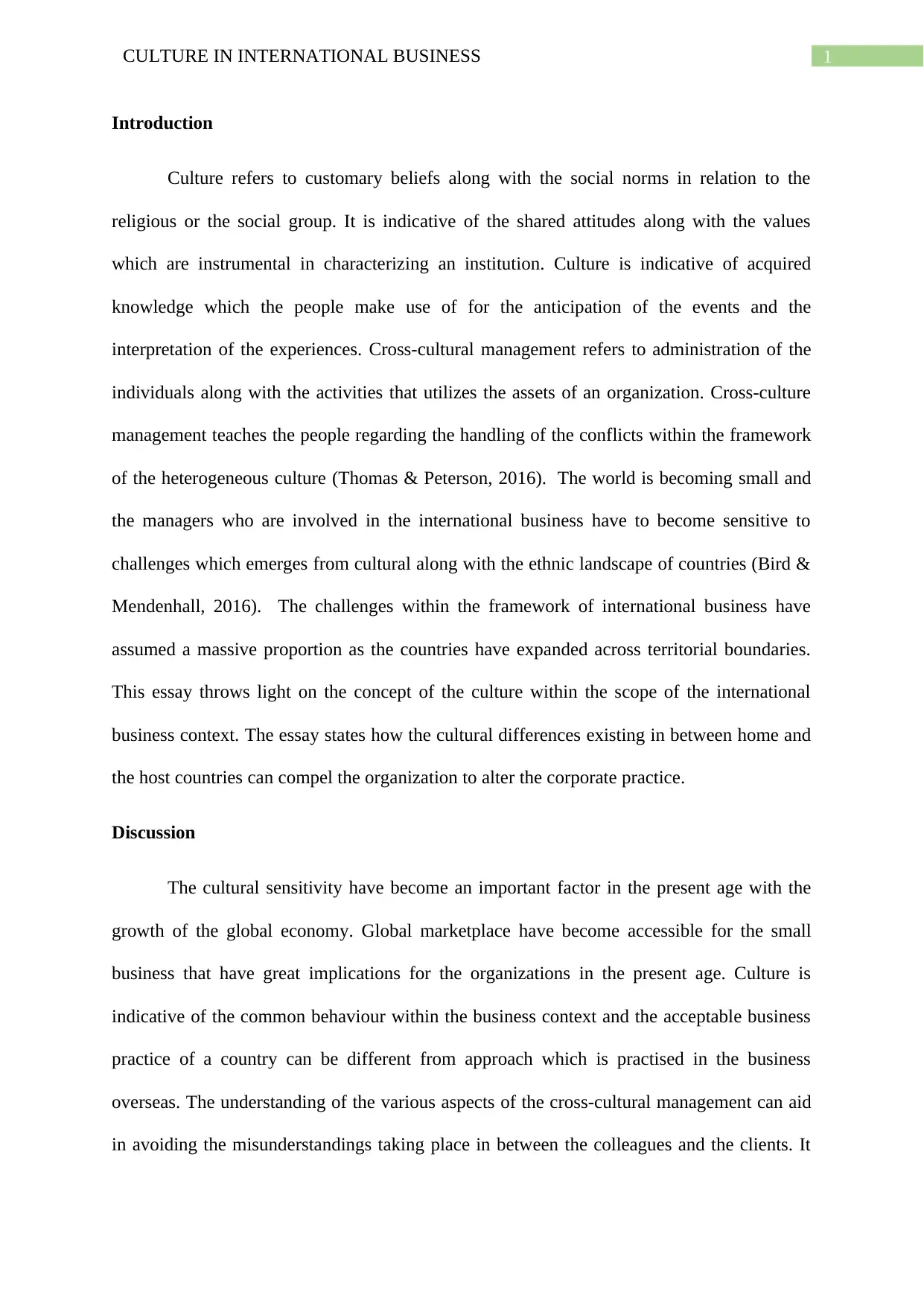
1CULTURE IN INTERNATIONAL BUSINESS
Introduction
Culture refers to customary beliefs along with the social norms in relation to the
religious or the social group. It is indicative of the shared attitudes along with the values
which are instrumental in characterizing an institution. Culture is indicative of acquired
knowledge which the people make use of for the anticipation of the events and the
interpretation of the experiences. Cross-cultural management refers to administration of the
individuals along with the activities that utilizes the assets of an organization. Cross-culture
management teaches the people regarding the handling of the conflicts within the framework
of the heterogeneous culture (Thomas & Peterson, 2016). The world is becoming small and
the managers who are involved in the international business have to become sensitive to
challenges which emerges from cultural along with the ethnic landscape of countries (Bird &
Mendenhall, 2016). The challenges within the framework of international business have
assumed a massive proportion as the countries have expanded across territorial boundaries.
This essay throws light on the concept of the culture within the scope of the international
business context. The essay states how the cultural differences existing in between home and
the host countries can compel the organization to alter the corporate practice.
Discussion
The cultural sensitivity have become an important factor in the present age with the
growth of the global economy. Global marketplace have become accessible for the small
business that have great implications for the organizations in the present age. Culture is
indicative of the common behaviour within the business context and the acceptable business
practice of a country can be different from approach which is practised in the business
overseas. The understanding of the various aspects of the cross-cultural management can aid
in avoiding the misunderstandings taking place in between the colleagues and the clients. It
Introduction
Culture refers to customary beliefs along with the social norms in relation to the
religious or the social group. It is indicative of the shared attitudes along with the values
which are instrumental in characterizing an institution. Culture is indicative of acquired
knowledge which the people make use of for the anticipation of the events and the
interpretation of the experiences. Cross-cultural management refers to administration of the
individuals along with the activities that utilizes the assets of an organization. Cross-culture
management teaches the people regarding the handling of the conflicts within the framework
of the heterogeneous culture (Thomas & Peterson, 2016). The world is becoming small and
the managers who are involved in the international business have to become sensitive to
challenges which emerges from cultural along with the ethnic landscape of countries (Bird &
Mendenhall, 2016). The challenges within the framework of international business have
assumed a massive proportion as the countries have expanded across territorial boundaries.
This essay throws light on the concept of the culture within the scope of the international
business context. The essay states how the cultural differences existing in between home and
the host countries can compel the organization to alter the corporate practice.
Discussion
The cultural sensitivity have become an important factor in the present age with the
growth of the global economy. Global marketplace have become accessible for the small
business that have great implications for the organizations in the present age. Culture is
indicative of the common behaviour within the business context and the acceptable business
practice of a country can be different from approach which is practised in the business
overseas. The understanding of the various aspects of the cross-cultural management can aid
in avoiding the misunderstandings taking place in between the colleagues and the clients. It
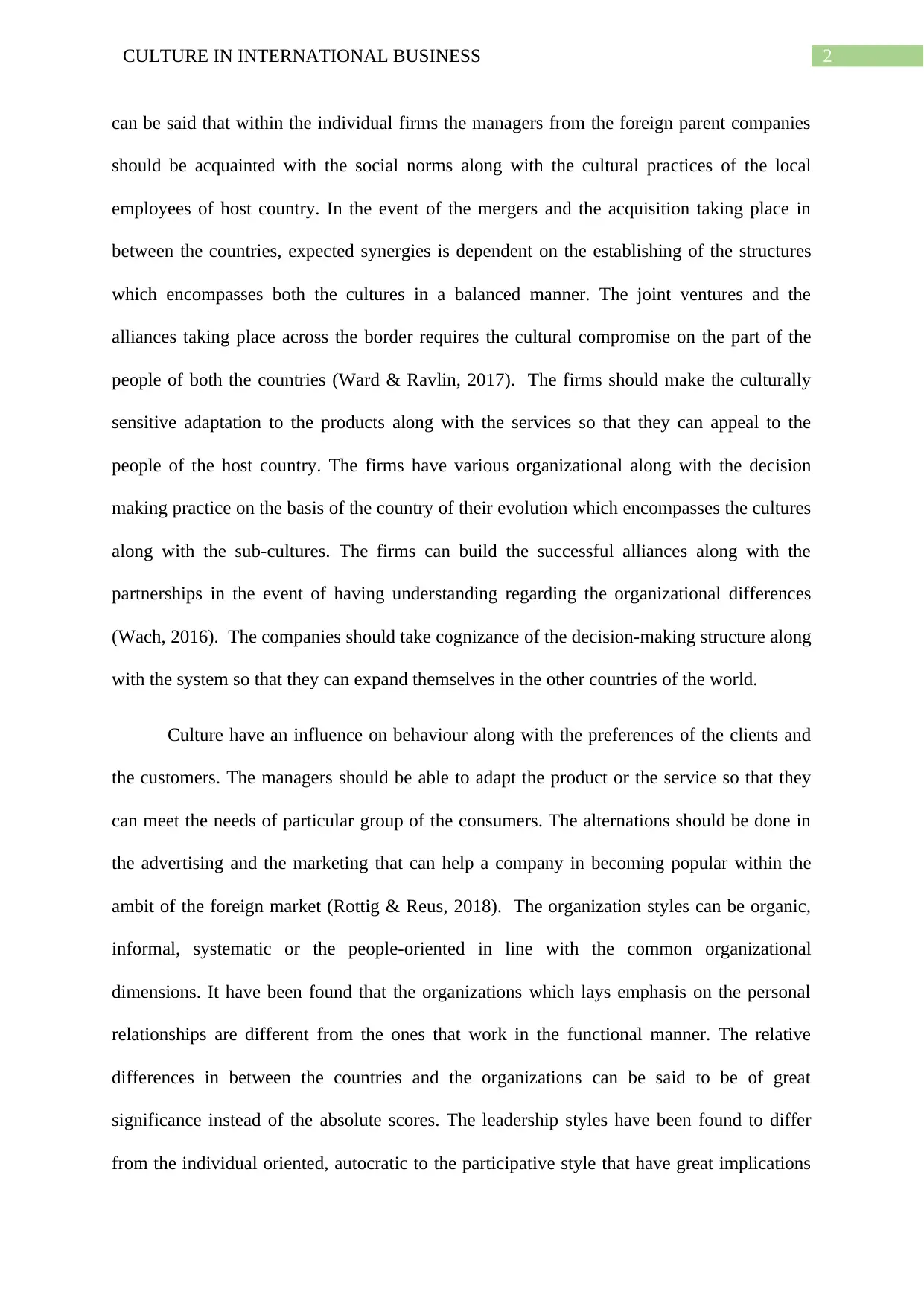
2CULTURE IN INTERNATIONAL BUSINESS
can be said that within the individual firms the managers from the foreign parent companies
should be acquainted with the social norms along with the cultural practices of the local
employees of host country. In the event of the mergers and the acquisition taking place in
between the countries, expected synergies is dependent on the establishing of the structures
which encompasses both the cultures in a balanced manner. The joint ventures and the
alliances taking place across the border requires the cultural compromise on the part of the
people of both the countries (Ward & Ravlin, 2017). The firms should make the culturally
sensitive adaptation to the products along with the services so that they can appeal to the
people of the host country. The firms have various organizational along with the decision
making practice on the basis of the country of their evolution which encompasses the cultures
along with the sub-cultures. The firms can build the successful alliances along with the
partnerships in the event of having understanding regarding the organizational differences
(Wach, 2016). The companies should take cognizance of the decision-making structure along
with the system so that they can expand themselves in the other countries of the world.
Culture have an influence on behaviour along with the preferences of the clients and
the customers. The managers should be able to adapt the product or the service so that they
can meet the needs of particular group of the consumers. The alternations should be done in
the advertising and the marketing that can help a company in becoming popular within the
ambit of the foreign market (Rottig & Reus, 2018). The organization styles can be organic,
informal, systematic or the people-oriented in line with the common organizational
dimensions. It have been found that the organizations which lays emphasis on the personal
relationships are different from the ones that work in the functional manner. The relative
differences in between the countries and the organizations can be said to be of great
significance instead of the absolute scores. The leadership styles have been found to differ
from the individual oriented, autocratic to the participative style that have great implications
can be said that within the individual firms the managers from the foreign parent companies
should be acquainted with the social norms along with the cultural practices of the local
employees of host country. In the event of the mergers and the acquisition taking place in
between the countries, expected synergies is dependent on the establishing of the structures
which encompasses both the cultures in a balanced manner. The joint ventures and the
alliances taking place across the border requires the cultural compromise on the part of the
people of both the countries (Ward & Ravlin, 2017). The firms should make the culturally
sensitive adaptation to the products along with the services so that they can appeal to the
people of the host country. The firms have various organizational along with the decision
making practice on the basis of the country of their evolution which encompasses the cultures
along with the sub-cultures. The firms can build the successful alliances along with the
partnerships in the event of having understanding regarding the organizational differences
(Wach, 2016). The companies should take cognizance of the decision-making structure along
with the system so that they can expand themselves in the other countries of the world.
Culture have an influence on behaviour along with the preferences of the clients and
the customers. The managers should be able to adapt the product or the service so that they
can meet the needs of particular group of the consumers. The alternations should be done in
the advertising and the marketing that can help a company in becoming popular within the
ambit of the foreign market (Rottig & Reus, 2018). The organization styles can be organic,
informal, systematic or the people-oriented in line with the common organizational
dimensions. It have been found that the organizations which lays emphasis on the personal
relationships are different from the ones that work in the functional manner. The relative
differences in between the countries and the organizations can be said to be of great
significance instead of the absolute scores. The leadership styles have been found to differ
from the individual oriented, autocratic to the participative style that have great implications
⊘ This is a preview!⊘
Do you want full access?
Subscribe today to unlock all pages.

Trusted by 1+ million students worldwide
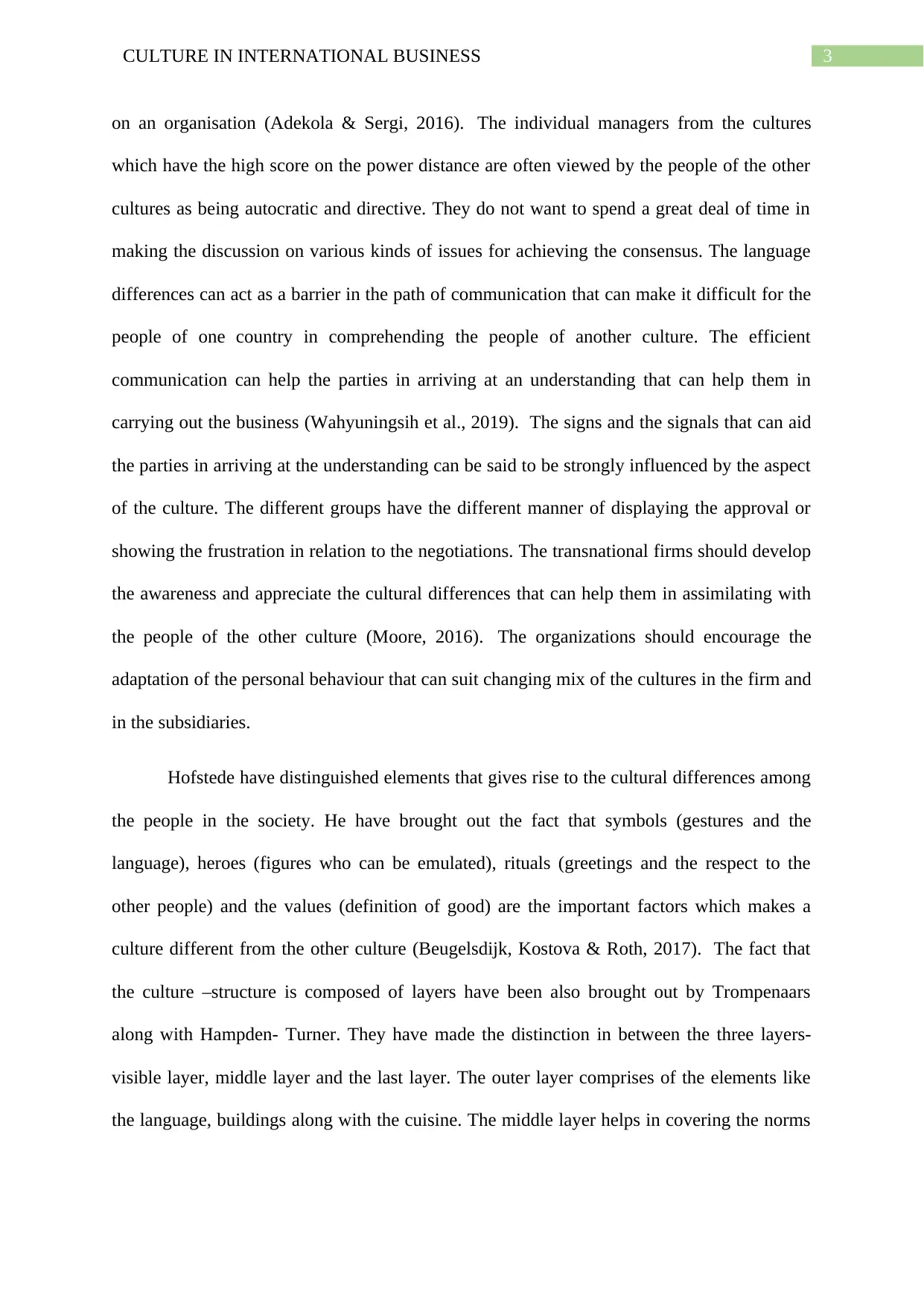
3CULTURE IN INTERNATIONAL BUSINESS
on an organisation (Adekola & Sergi, 2016). The individual managers from the cultures
which have the high score on the power distance are often viewed by the people of the other
cultures as being autocratic and directive. They do not want to spend a great deal of time in
making the discussion on various kinds of issues for achieving the consensus. The language
differences can act as a barrier in the path of communication that can make it difficult for the
people of one country in comprehending the people of another culture. The efficient
communication can help the parties in arriving at an understanding that can help them in
carrying out the business (Wahyuningsih et al., 2019). The signs and the signals that can aid
the parties in arriving at the understanding can be said to be strongly influenced by the aspect
of the culture. The different groups have the different manner of displaying the approval or
showing the frustration in relation to the negotiations. The transnational firms should develop
the awareness and appreciate the cultural differences that can help them in assimilating with
the people of the other culture (Moore, 2016). The organizations should encourage the
adaptation of the personal behaviour that can suit changing mix of the cultures in the firm and
in the subsidiaries.
Hofstede have distinguished elements that gives rise to the cultural differences among
the people in the society. He have brought out the fact that symbols (gestures and the
language), heroes (figures who can be emulated), rituals (greetings and the respect to the
other people) and the values (definition of good) are the important factors which makes a
culture different from the other culture (Beugelsdijk, Kostova & Roth, 2017). The fact that
the culture –structure is composed of layers have been also brought out by Trompenaars
along with Hampden- Turner. They have made the distinction in between the three layers-
visible layer, middle layer and the last layer. The outer layer comprises of the elements like
the language, buildings along with the cuisine. The middle layer helps in covering the norms
on an organisation (Adekola & Sergi, 2016). The individual managers from the cultures
which have the high score on the power distance are often viewed by the people of the other
cultures as being autocratic and directive. They do not want to spend a great deal of time in
making the discussion on various kinds of issues for achieving the consensus. The language
differences can act as a barrier in the path of communication that can make it difficult for the
people of one country in comprehending the people of another culture. The efficient
communication can help the parties in arriving at an understanding that can help them in
carrying out the business (Wahyuningsih et al., 2019). The signs and the signals that can aid
the parties in arriving at the understanding can be said to be strongly influenced by the aspect
of the culture. The different groups have the different manner of displaying the approval or
showing the frustration in relation to the negotiations. The transnational firms should develop
the awareness and appreciate the cultural differences that can help them in assimilating with
the people of the other culture (Moore, 2016). The organizations should encourage the
adaptation of the personal behaviour that can suit changing mix of the cultures in the firm and
in the subsidiaries.
Hofstede have distinguished elements that gives rise to the cultural differences among
the people in the society. He have brought out the fact that symbols (gestures and the
language), heroes (figures who can be emulated), rituals (greetings and the respect to the
other people) and the values (definition of good) are the important factors which makes a
culture different from the other culture (Beugelsdijk, Kostova & Roth, 2017). The fact that
the culture –structure is composed of layers have been also brought out by Trompenaars
along with Hampden- Turner. They have made the distinction in between the three layers-
visible layer, middle layer and the last layer. The outer layer comprises of the elements like
the language, buildings along with the cuisine. The middle layer helps in covering the norms
Paraphrase This Document
Need a fresh take? Get an instant paraphrase of this document with our AI Paraphraser
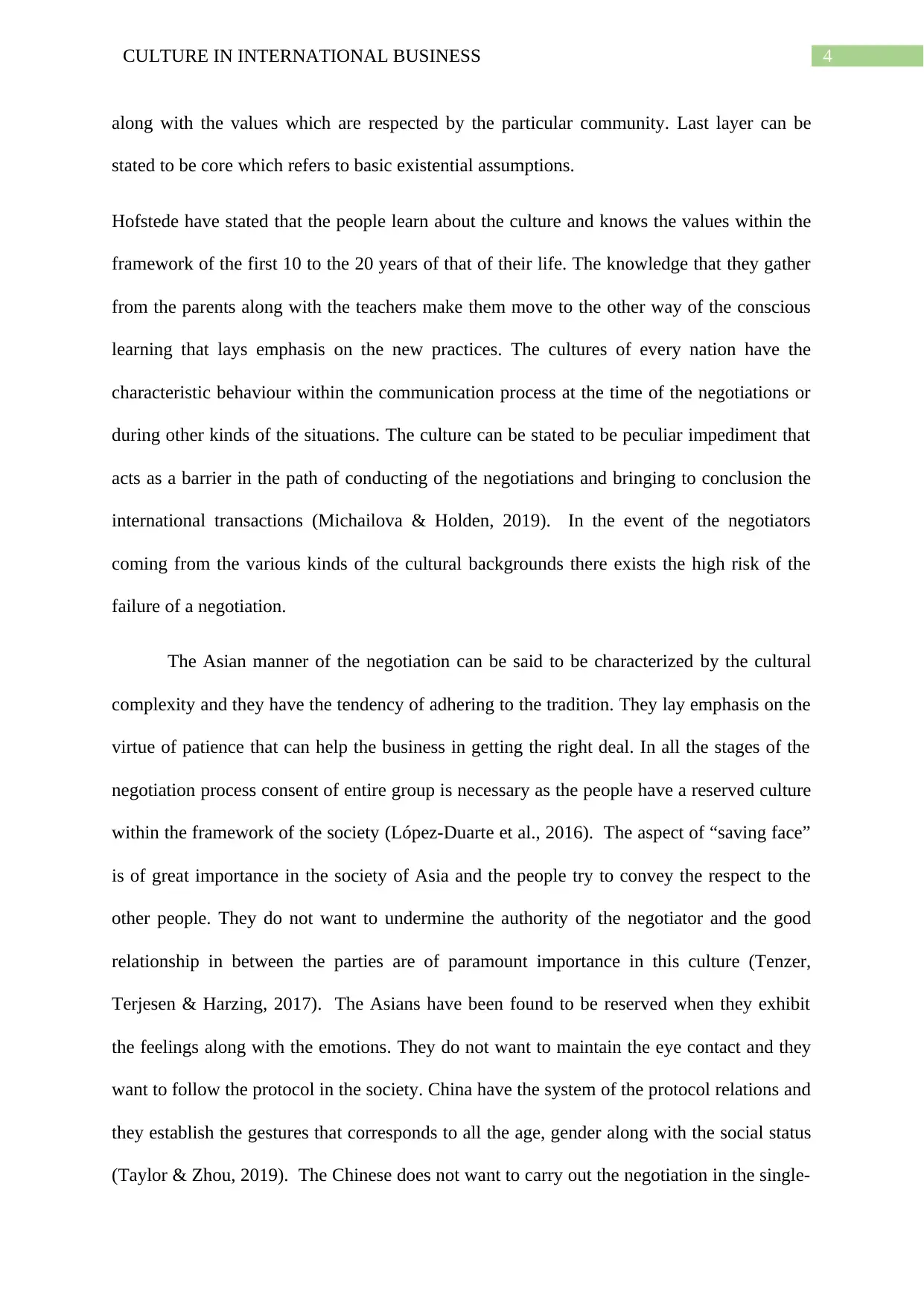
4CULTURE IN INTERNATIONAL BUSINESS
along with the values which are respected by the particular community. Last layer can be
stated to be core which refers to basic existential assumptions.
Hofstede have stated that the people learn about the culture and knows the values within the
framework of the first 10 to the 20 years of that of their life. The knowledge that they gather
from the parents along with the teachers make them move to the other way of the conscious
learning that lays emphasis on the new practices. The cultures of every nation have the
characteristic behaviour within the communication process at the time of the negotiations or
during other kinds of the situations. The culture can be stated to be peculiar impediment that
acts as a barrier in the path of conducting of the negotiations and bringing to conclusion the
international transactions (Michailova & Holden, 2019). In the event of the negotiators
coming from the various kinds of the cultural backgrounds there exists the high risk of the
failure of a negotiation.
The Asian manner of the negotiation can be said to be characterized by the cultural
complexity and they have the tendency of adhering to the tradition. They lay emphasis on the
virtue of patience that can help the business in getting the right deal. In all the stages of the
negotiation process consent of entire group is necessary as the people have a reserved culture
within the framework of the society (López-Duarte et al., 2016). The aspect of “saving face”
is of great importance in the society of Asia and the people try to convey the respect to the
other people. They do not want to undermine the authority of the negotiator and the good
relationship in between the parties are of paramount importance in this culture (Tenzer,
Terjesen & Harzing, 2017). The Asians have been found to be reserved when they exhibit
the feelings along with the emotions. They do not want to maintain the eye contact and they
want to follow the protocol in the society. China have the system of the protocol relations and
they establish the gestures that corresponds to all the age, gender along with the social status
(Taylor & Zhou, 2019). The Chinese does not want to carry out the negotiation in the single-
along with the values which are respected by the particular community. Last layer can be
stated to be core which refers to basic existential assumptions.
Hofstede have stated that the people learn about the culture and knows the values within the
framework of the first 10 to the 20 years of that of their life. The knowledge that they gather
from the parents along with the teachers make them move to the other way of the conscious
learning that lays emphasis on the new practices. The cultures of every nation have the
characteristic behaviour within the communication process at the time of the negotiations or
during other kinds of the situations. The culture can be stated to be peculiar impediment that
acts as a barrier in the path of conducting of the negotiations and bringing to conclusion the
international transactions (Michailova & Holden, 2019). In the event of the negotiators
coming from the various kinds of the cultural backgrounds there exists the high risk of the
failure of a negotiation.
The Asian manner of the negotiation can be said to be characterized by the cultural
complexity and they have the tendency of adhering to the tradition. They lay emphasis on the
virtue of patience that can help the business in getting the right deal. In all the stages of the
negotiation process consent of entire group is necessary as the people have a reserved culture
within the framework of the society (López-Duarte et al., 2016). The aspect of “saving face”
is of great importance in the society of Asia and the people try to convey the respect to the
other people. They do not want to undermine the authority of the negotiator and the good
relationship in between the parties are of paramount importance in this culture (Tenzer,
Terjesen & Harzing, 2017). The Asians have been found to be reserved when they exhibit
the feelings along with the emotions. They do not want to maintain the eye contact and they
want to follow the protocol in the society. China have the system of the protocol relations and
they establish the gestures that corresponds to all the age, gender along with the social status
(Taylor & Zhou, 2019). The Chinese does not want to carry out the negotiation in the single-
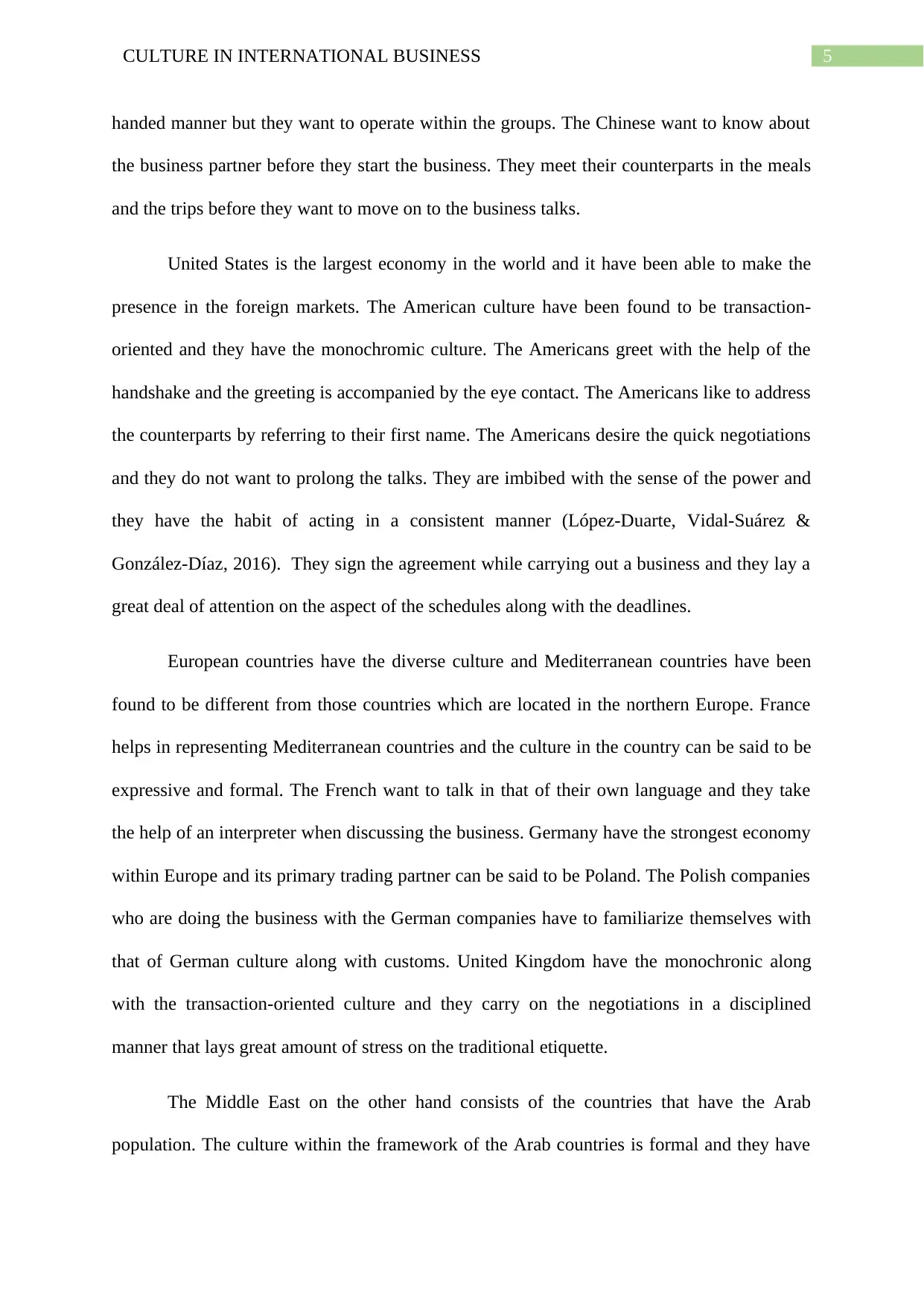
5CULTURE IN INTERNATIONAL BUSINESS
handed manner but they want to operate within the groups. The Chinese want to know about
the business partner before they start the business. They meet their counterparts in the meals
and the trips before they want to move on to the business talks.
United States is the largest economy in the world and it have been able to make the
presence in the foreign markets. The American culture have been found to be transaction-
oriented and they have the monochromic culture. The Americans greet with the help of the
handshake and the greeting is accompanied by the eye contact. The Americans like to address
the counterparts by referring to their first name. The Americans desire the quick negotiations
and they do not want to prolong the talks. They are imbibed with the sense of the power and
they have the habit of acting in a consistent manner (López‐Duarte, Vidal‐Suárez &
González‐Díaz, 2016). They sign the agreement while carrying out a business and they lay a
great deal of attention on the aspect of the schedules along with the deadlines.
European countries have the diverse culture and Mediterranean countries have been
found to be different from those countries which are located in the northern Europe. France
helps in representing Mediterranean countries and the culture in the country can be said to be
expressive and formal. The French want to talk in that of their own language and they take
the help of an interpreter when discussing the business. Germany have the strongest economy
within Europe and its primary trading partner can be said to be Poland. The Polish companies
who are doing the business with the German companies have to familiarize themselves with
that of German culture along with customs. United Kingdom have the monochronic along
with the transaction-oriented culture and they carry on the negotiations in a disciplined
manner that lays great amount of stress on the traditional etiquette.
The Middle East on the other hand consists of the countries that have the Arab
population. The culture within the framework of the Arab countries is formal and they have
handed manner but they want to operate within the groups. The Chinese want to know about
the business partner before they start the business. They meet their counterparts in the meals
and the trips before they want to move on to the business talks.
United States is the largest economy in the world and it have been able to make the
presence in the foreign markets. The American culture have been found to be transaction-
oriented and they have the monochromic culture. The Americans greet with the help of the
handshake and the greeting is accompanied by the eye contact. The Americans like to address
the counterparts by referring to their first name. The Americans desire the quick negotiations
and they do not want to prolong the talks. They are imbibed with the sense of the power and
they have the habit of acting in a consistent manner (López‐Duarte, Vidal‐Suárez &
González‐Díaz, 2016). They sign the agreement while carrying out a business and they lay a
great deal of attention on the aspect of the schedules along with the deadlines.
European countries have the diverse culture and Mediterranean countries have been
found to be different from those countries which are located in the northern Europe. France
helps in representing Mediterranean countries and the culture in the country can be said to be
expressive and formal. The French want to talk in that of their own language and they take
the help of an interpreter when discussing the business. Germany have the strongest economy
within Europe and its primary trading partner can be said to be Poland. The Polish companies
who are doing the business with the German companies have to familiarize themselves with
that of German culture along with customs. United Kingdom have the monochronic along
with the transaction-oriented culture and they carry on the negotiations in a disciplined
manner that lays great amount of stress on the traditional etiquette.
The Middle East on the other hand consists of the countries that have the Arab
population. The culture within the framework of the Arab countries is formal and they have
⊘ This is a preview!⊘
Do you want full access?
Subscribe today to unlock all pages.

Trusted by 1+ million students worldwide
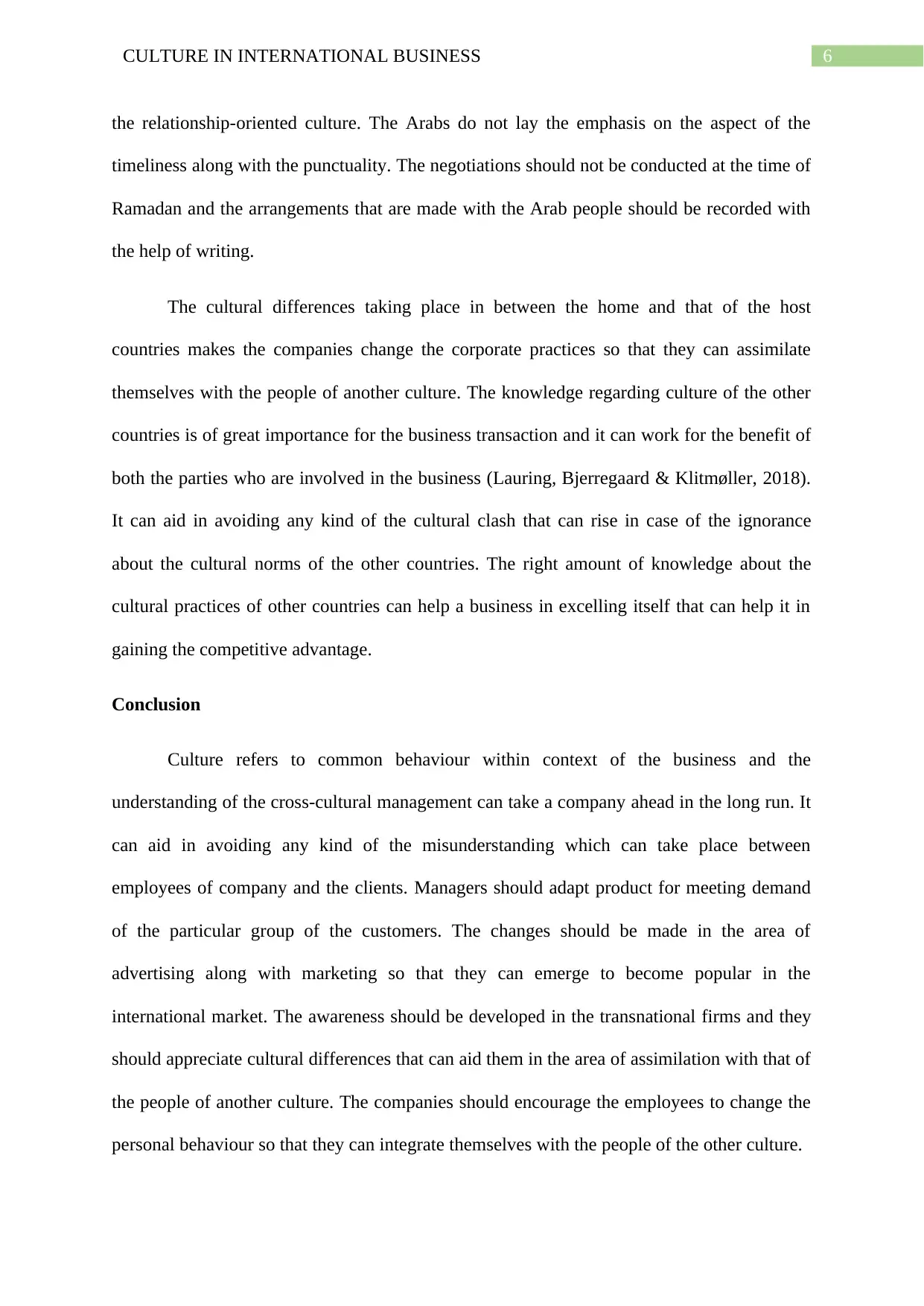
6CULTURE IN INTERNATIONAL BUSINESS
the relationship-oriented culture. The Arabs do not lay the emphasis on the aspect of the
timeliness along with the punctuality. The negotiations should not be conducted at the time of
Ramadan and the arrangements that are made with the Arab people should be recorded with
the help of writing.
The cultural differences taking place in between the home and that of the host
countries makes the companies change the corporate practices so that they can assimilate
themselves with the people of another culture. The knowledge regarding culture of the other
countries is of great importance for the business transaction and it can work for the benefit of
both the parties who are involved in the business (Lauring, Bjerregaard & Klitmøller, 2018).
It can aid in avoiding any kind of the cultural clash that can rise in case of the ignorance
about the cultural norms of the other countries. The right amount of knowledge about the
cultural practices of other countries can help a business in excelling itself that can help it in
gaining the competitive advantage.
Conclusion
Culture refers to common behaviour within context of the business and the
understanding of the cross-cultural management can take a company ahead in the long run. It
can aid in avoiding any kind of the misunderstanding which can take place between
employees of company and the clients. Managers should adapt product for meeting demand
of the particular group of the customers. The changes should be made in the area of
advertising along with marketing so that they can emerge to become popular in the
international market. The awareness should be developed in the transnational firms and they
should appreciate cultural differences that can aid them in the area of assimilation with that of
the people of another culture. The companies should encourage the employees to change the
personal behaviour so that they can integrate themselves with the people of the other culture.
the relationship-oriented culture. The Arabs do not lay the emphasis on the aspect of the
timeliness along with the punctuality. The negotiations should not be conducted at the time of
Ramadan and the arrangements that are made with the Arab people should be recorded with
the help of writing.
The cultural differences taking place in between the home and that of the host
countries makes the companies change the corporate practices so that they can assimilate
themselves with the people of another culture. The knowledge regarding culture of the other
countries is of great importance for the business transaction and it can work for the benefit of
both the parties who are involved in the business (Lauring, Bjerregaard & Klitmøller, 2018).
It can aid in avoiding any kind of the cultural clash that can rise in case of the ignorance
about the cultural norms of the other countries. The right amount of knowledge about the
cultural practices of other countries can help a business in excelling itself that can help it in
gaining the competitive advantage.
Conclusion
Culture refers to common behaviour within context of the business and the
understanding of the cross-cultural management can take a company ahead in the long run. It
can aid in avoiding any kind of the misunderstanding which can take place between
employees of company and the clients. Managers should adapt product for meeting demand
of the particular group of the customers. The changes should be made in the area of
advertising along with marketing so that they can emerge to become popular in the
international market. The awareness should be developed in the transnational firms and they
should appreciate cultural differences that can aid them in the area of assimilation with that of
the people of another culture. The companies should encourage the employees to change the
personal behaviour so that they can integrate themselves with the people of the other culture.
Paraphrase This Document
Need a fresh take? Get an instant paraphrase of this document with our AI Paraphraser

7CULTURE IN INTERNATIONAL BUSINESS
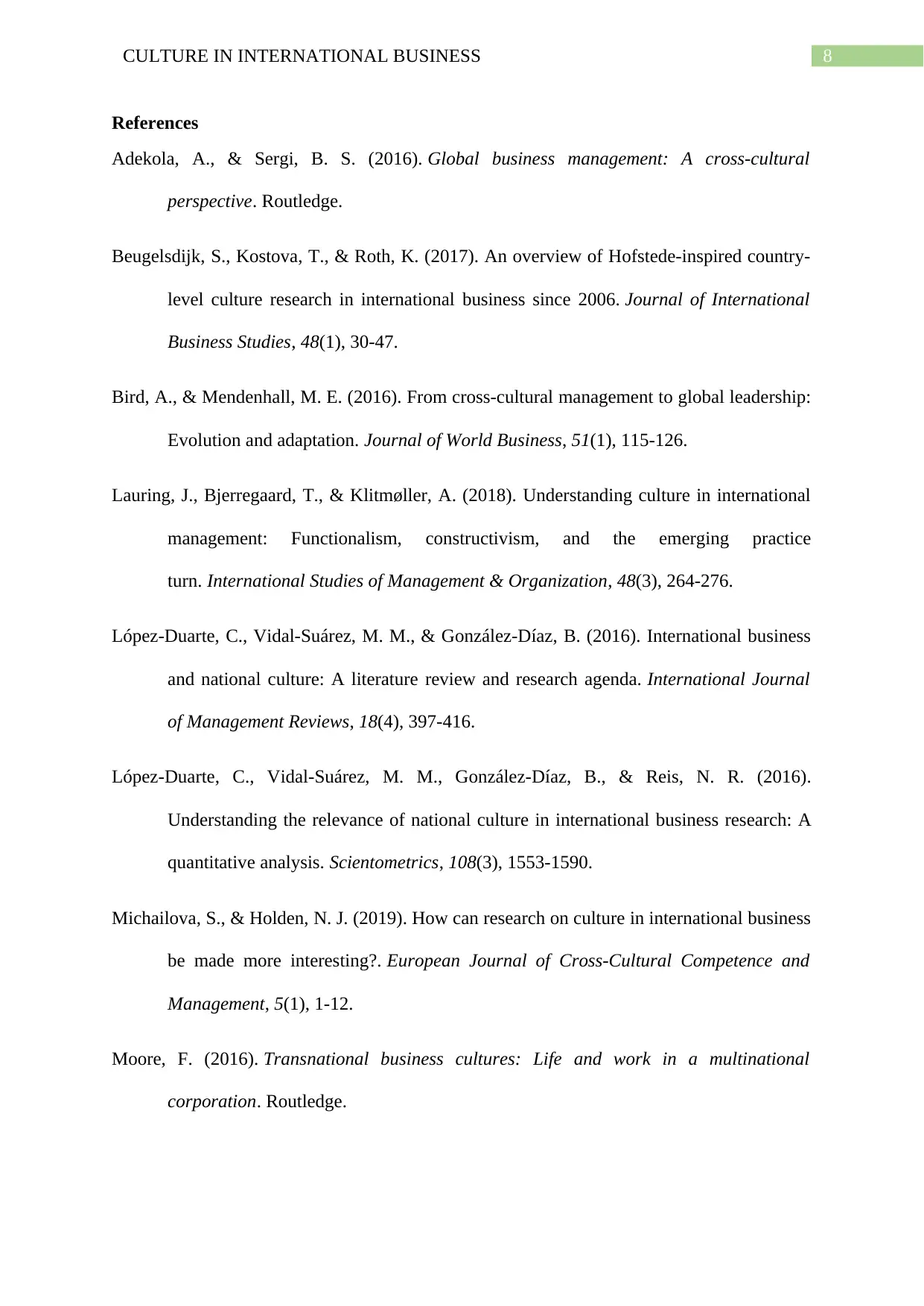
8CULTURE IN INTERNATIONAL BUSINESS
References
Adekola, A., & Sergi, B. S. (2016). Global business management: A cross-cultural
perspective. Routledge.
Beugelsdijk, S., Kostova, T., & Roth, K. (2017). An overview of Hofstede-inspired country-
level culture research in international business since 2006. Journal of International
Business Studies, 48(1), 30-47.
Bird, A., & Mendenhall, M. E. (2016). From cross-cultural management to global leadership:
Evolution and adaptation. Journal of World Business, 51(1), 115-126.
Lauring, J., Bjerregaard, T., & Klitmøller, A. (2018). Understanding culture in international
management: Functionalism, constructivism, and the emerging practice
turn. International Studies of Management & Organization, 48(3), 264-276.
López‐Duarte, C., Vidal‐Suárez, M. M., & González‐Díaz, B. (2016). International business
and national culture: A literature review and research agenda. International Journal
of Management Reviews, 18(4), 397-416.
López-Duarte, C., Vidal-Suárez, M. M., González-Díaz, B., & Reis, N. R. (2016).
Understanding the relevance of national culture in international business research: A
quantitative analysis. Scientometrics, 108(3), 1553-1590.
Michailova, S., & Holden, N. J. (2019). How can research on culture in international business
be made more interesting?. European Journal of Cross-Cultural Competence and
Management, 5(1), 1-12.
Moore, F. (2016). Transnational business cultures: Life and work in a multinational
corporation. Routledge.
References
Adekola, A., & Sergi, B. S. (2016). Global business management: A cross-cultural
perspective. Routledge.
Beugelsdijk, S., Kostova, T., & Roth, K. (2017). An overview of Hofstede-inspired country-
level culture research in international business since 2006. Journal of International
Business Studies, 48(1), 30-47.
Bird, A., & Mendenhall, M. E. (2016). From cross-cultural management to global leadership:
Evolution and adaptation. Journal of World Business, 51(1), 115-126.
Lauring, J., Bjerregaard, T., & Klitmøller, A. (2018). Understanding culture in international
management: Functionalism, constructivism, and the emerging practice
turn. International Studies of Management & Organization, 48(3), 264-276.
López‐Duarte, C., Vidal‐Suárez, M. M., & González‐Díaz, B. (2016). International business
and national culture: A literature review and research agenda. International Journal
of Management Reviews, 18(4), 397-416.
López-Duarte, C., Vidal-Suárez, M. M., González-Díaz, B., & Reis, N. R. (2016).
Understanding the relevance of national culture in international business research: A
quantitative analysis. Scientometrics, 108(3), 1553-1590.
Michailova, S., & Holden, N. J. (2019). How can research on culture in international business
be made more interesting?. European Journal of Cross-Cultural Competence and
Management, 5(1), 1-12.
Moore, F. (2016). Transnational business cultures: Life and work in a multinational
corporation. Routledge.
⊘ This is a preview!⊘
Do you want full access?
Subscribe today to unlock all pages.

Trusted by 1+ million students worldwide
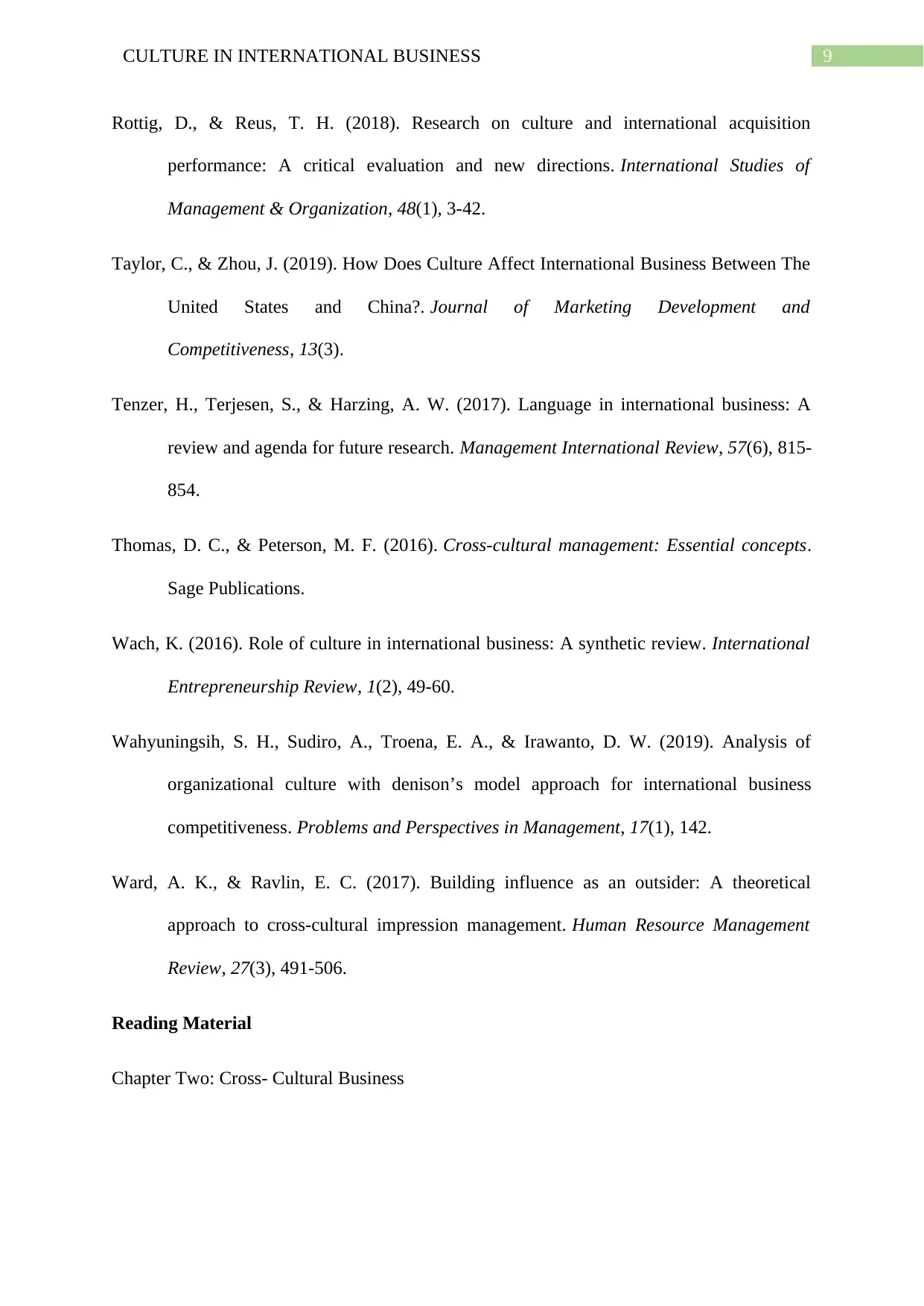
9CULTURE IN INTERNATIONAL BUSINESS
Rottig, D., & Reus, T. H. (2018). Research on culture and international acquisition
performance: A critical evaluation and new directions. International Studies of
Management & Organization, 48(1), 3-42.
Taylor, C., & Zhou, J. (2019). How Does Culture Affect International Business Between The
United States and China?. Journal of Marketing Development and
Competitiveness, 13(3).
Tenzer, H., Terjesen, S., & Harzing, A. W. (2017). Language in international business: A
review and agenda for future research. Management International Review, 57(6), 815-
854.
Thomas, D. C., & Peterson, M. F. (2016). Cross-cultural management: Essential concepts.
Sage Publications.
Wach, K. (2016). Role of culture in international business: A synthetic review. International
Entrepreneurship Review, 1(2), 49-60.
Wahyuningsih, S. H., Sudiro, A., Troena, E. A., & Irawanto, D. W. (2019). Analysis of
organizational culture with denison’s model approach for international business
competitiveness. Problems and Perspectives in Management, 17(1), 142.
Ward, A. K., & Ravlin, E. C. (2017). Building influence as an outsider: A theoretical
approach to cross-cultural impression management. Human Resource Management
Review, 27(3), 491-506.
Reading Material
Chapter Two: Cross- Cultural Business
Rottig, D., & Reus, T. H. (2018). Research on culture and international acquisition
performance: A critical evaluation and new directions. International Studies of
Management & Organization, 48(1), 3-42.
Taylor, C., & Zhou, J. (2019). How Does Culture Affect International Business Between The
United States and China?. Journal of Marketing Development and
Competitiveness, 13(3).
Tenzer, H., Terjesen, S., & Harzing, A. W. (2017). Language in international business: A
review and agenda for future research. Management International Review, 57(6), 815-
854.
Thomas, D. C., & Peterson, M. F. (2016). Cross-cultural management: Essential concepts.
Sage Publications.
Wach, K. (2016). Role of culture in international business: A synthetic review. International
Entrepreneurship Review, 1(2), 49-60.
Wahyuningsih, S. H., Sudiro, A., Troena, E. A., & Irawanto, D. W. (2019). Analysis of
organizational culture with denison’s model approach for international business
competitiveness. Problems and Perspectives in Management, 17(1), 142.
Ward, A. K., & Ravlin, E. C. (2017). Building influence as an outsider: A theoretical
approach to cross-cultural impression management. Human Resource Management
Review, 27(3), 491-506.
Reading Material
Chapter Two: Cross- Cultural Business
1 out of 10
Related Documents
Your All-in-One AI-Powered Toolkit for Academic Success.
+13062052269
info@desklib.com
Available 24*7 on WhatsApp / Email
![[object Object]](/_next/static/media/star-bottom.7253800d.svg)
Unlock your academic potential
Copyright © 2020–2025 A2Z Services. All Rights Reserved. Developed and managed by ZUCOL.




